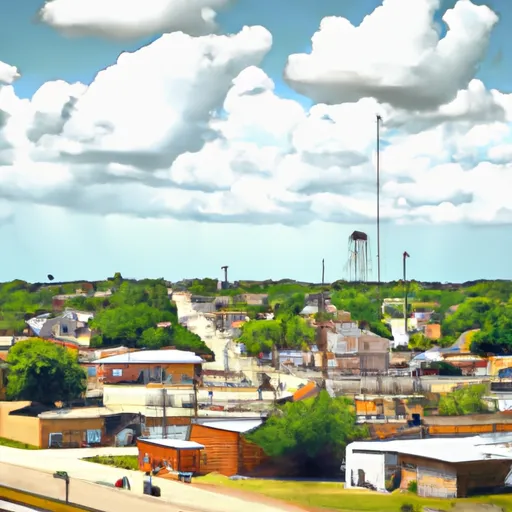-
 Snoflo Premium
Snoflo Premium
Get unlimited access to all our content
With no Ad interruptions! - Start Your Free Trial Login with existing account
Rotan
Eden Index
Climate
9.4
•
Recreation
•
Community
1.4
•
Safeguard
4.1/10

Rotan, Texas is a small town located in Fisher County in the west-central part of the state. The climate in Rotan is classified as semi-arid, with hot summers and mild winters. Summers are typically hot and dry, with temperatures often reaching the high 90s Fahrenheit, while winters are generally cool and dry, with temperatures dropping to the mid-30s. The region receives an average annual precipitation of around 20 inches, with the majority falling during the spring and summer months.
Hydrologically, Rotan is part of the Brazos River watershed. It is also surrounded by several smaller creeks and reservoirs, providing opportunities for fishing, boating, and other water-based activities. The area is known for its diverse aquatic wildlife, including bass, catfish, and crappie, making it a popular destination for anglers.
In terms of outdoor recreation, Rotan offers various opportunities for nature enthusiasts. The nearby Double Mountain Fork Brazos River and Lake Stamford are excellent spots for fishing and water sports. Additionally, the surrounding landscape of rolling hills and plains provides an ideal setting for hiking, camping, and wildlife viewing. Overall, Rotan offers a quaint Texan experience with its climate, hydrology, and diverse outdoor recreation opportunities.
What is the Eden Index?
The Snoflo Eden Index serves as a comprehensive rating system for regions, evaluating their desirability through a holistic assessment of climate health, outdoor recreation opportunities, and natural disaster risk, acknowledging the profound impact of these factors on livability and well-being.
Climate Health Indicator (CHI): 9.4
Rotan receives approximately
590mm of rain per year,
with humidity levels near 78%
and air temperatures averaging around
18°C.
Rotan has a plant hardyness factor of
7, meaning
plants and agriculture in this region tend to thrive during the non-winter months.
By considering the ideal temperature range, reliable water supplies, clean air, and stable seasonal rain or snowpacks, the Climate Health Indicator (CHI) underscores the significance of a healthy climate as the foundation for quality living.
A healthy climate is paramount for ensuring a high quality of life and livability in a region, fostering both physical well-being and environmental harmony. This can be characterized by ideal temperatures, reliable access to water supplies, clean air, and consistent seasonal rain or snowpacks.
Weather Forecast
Streamflow Conditions
Brazos Headwaters
Area Rivers
Brazos Headwaters
Snowpack Depths
Brazos Headwaters
Reservoir Storage Capacity
Brazos Headwaters
Groundwater Levels
Recreational Opportunity Index (ROI):
The Recreational Opportunity Index (ROI) recognizes the value of outdoor recreational options, such as parks, hiking trails, camping sites, and fishing spots, while acknowledging that climate plays a pivotal role in ensuring the comfort and consistency of these experiences.
Access to outdoor recreational opportunities, encompassing activities such as parks, hiking, camping, and fishing, is crucial for overall well-being, and the climate plays a pivotal role in enabling and enhancing these experiences, ensuring that individuals can engage in nature-based activities comfortably and consistently.
Camping Areas
| Campground | Campsites | Reservations | Toilets | Showers | Elevation |
|---|---|---|---|---|---|
| Lake Knifrim County Park | None | 1,779 ft | |||
| Jayton RV Park | None | 2,008 ft | |||
| Lake Sweetwater Park | 20 | 2,074 ft | |||
| Robert Lee City Park | 8 | 1,842 ft | |||
| Wildcat Park - Spence Reservoir | 14 | 1,932 ft | |||
| Rough Creek Park - Spence Reservoir | None | 1,944 ft | |||
| Paint Creek Park - Spence Reservoir | 10 | 1,925 ft |
Nearby Fishing
Nearby Ski Areas
Catastrophe Safeguard Index (CSI):
The Catastrophe Safeguard Index (CSI) recognizes that natural disaster risk, encompassing floods, fires, hurricanes, and tornadoes, can drastically affect safety and the overall appeal of an area.
The level of natural disaster risk in a region significantly affects safety and the overall livability, with climate change amplifying these risks by potentially increasing the frequency and intensity of events like floods, fires, hurricanes, and tornadoes, thereby posing substantial challenges to community resilience and well-being.
Community Resilience Indicator (CRI): 1.4
The Community Resilience Indicator (CRI) recognizes that education, healthcare, and socioeconomics are crucial to the well-being of a region. The CRI acknowledges the profound impact of these elements on residents' overall quality of life. By evaluating educational resources, healthcare accessibility, and economic inclusivity, the index captures the essential aspects that contribute to a thriving community, fostering resident satisfaction, equity, and social cohesion.

